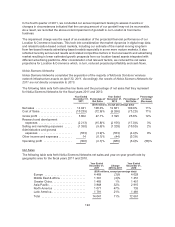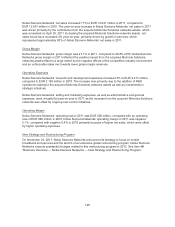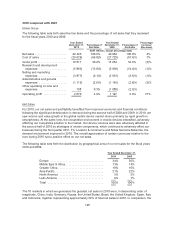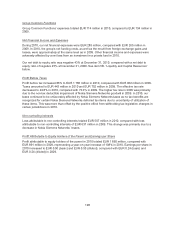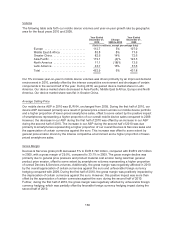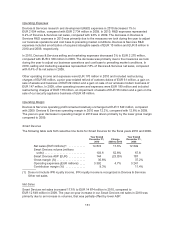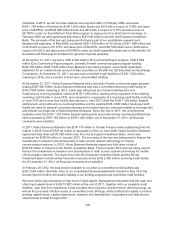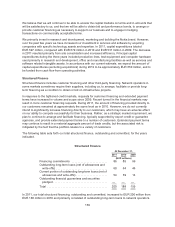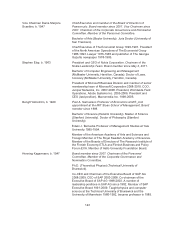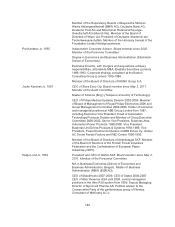Nokia 2011 Annual Report Download - page 136
Download and view the complete annual report
Please find page 136 of the 2011 Nokia annual report below. You can navigate through the pages in the report by either clicking on the pages listed below, or by using the keyword search tool below to find specific information within the annual report.
Operating Expenses
Location & Commerce R&D expenses in 2010 were EUR 1 011 million, compared with EUR 902 million
in 2009. Location & Commerce R&D expenses included amortization of intangible assets recorded as
part of Nokia’s acquisition of NAVTEQ totaling EUR 366 million and EUR 346 million in 2010 and 2009,
respectively. R&D expenses in 2010 were also driven by increased investment in Location &
Commerce map database related to geographic expansion and quality improvements during the year.
R&D expenses represented 116.3% of Location & Commerce net sales in 2010, compared to 119.3%
of Location & Commerce net sales in 2009.
Location & Commerce selling and marketing expenses in 2010 were EUR 274 million, compared with
EUR 253 million in 2009. Location & Commerce selling and marketing expenses primarily consisted of
amortization of intangible assets recorded as part of Nokia’s acquisition of NAVTEQ totaling
EUR 121 million and EUR 115 million in 2010 and 2009, respectively. Selling and marketing expenses
in 2010 were also driven by investments to grow Location & Commerce’s worldwide sales force and
expand the breadth of its product offerings. Selling and marketing expenses represented 31.5% of
Location & Commerce net sales in 2010, compared to 33.5% of Location & Commerce net sales in
2009.
Operating Margin
Location & Commerce operating loss was EUR 663 million in 2010, compared to a loss of
EUR 594 million in 2009. Location & Commerce operating margin was negative 76.3% in 2010,
compared to negative 78.6% in 2009. The year-on-year increase in operating margin was primarily due
to lower operating expenses as a percentage of net sales offset to some extent by a lower gross
margin.
Nokia Siemens Networks
According to our estimates, the mobile infrastructure market remained flat in euro terms in 2010
compared to 2009 with the trend varying, depending on region. In the first half of 2010 there was some
easing of the difficult market conditions experienced in 2009—when the deterioration in global
economic conditions caused many operators to delay investments in network infrastructure—but this
improvement was offset by two industry specific factors that caused the overall market to continue to
decline. First, a global component shortage restricted deliveries of certain products. Second, the
introduction of new security clearance processes for telecommunications in India, prevented the
completion of product sales to customers during the second and third quarters of the year. These
issues continued to impact, but were less influential in the second half of the year, when the market
was more buoyant overall.
In 2010, in regional terms there was significant growth in North America as operators invested heavily
in upgrading both fixed and wireless networks. The Latin American market also recovered from the
severe downturn it experienced in 2009 and saw renewed operator investment. In Europe there was
slight growth. The Asia Pacific market was varied with growth in Japan and China,while India
contracted year-on-year as a result of the security clearance issue, despite 3G investment in the
second half. The Middle East and Africa region remained difficult as continued financial restraints and
a wave of consolidation in the market delayed investment.
In segment terms, the managed services market grew and there was continued strong investment in
mobile broadband infrastructure in 2010.
Globally in 2010, the network infrastructure equipment segment continued to be affected by significant
price erosion of the equipment, largely as a result of maturing technologies and intense price
competition, especially from Asian vendors.
134


